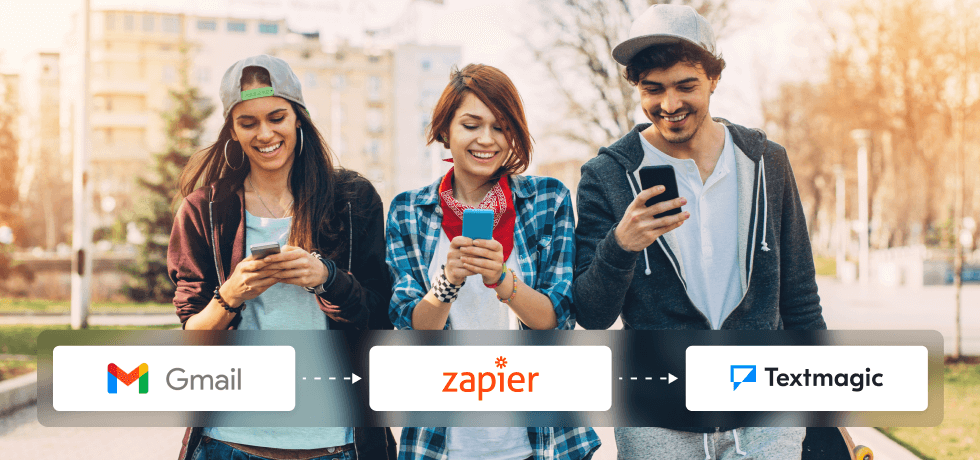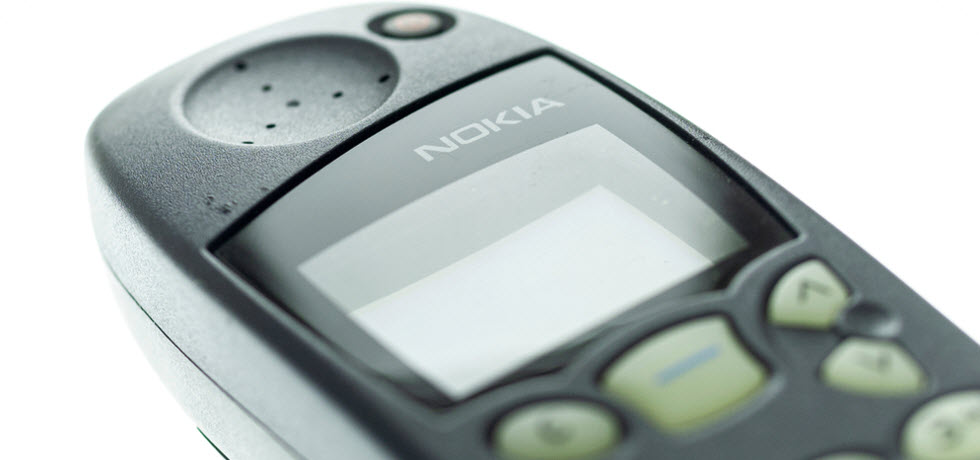
From the early days of mobile communication to the bustling digital age, one form of connection has stood the test of time and revolutionized the way we interact – texting. A simple yet powerful tool that has transformed from sending short messages to an array of multimedia, text messaging, has a fascinating history that has shaped the way we communicate in the modern world.
In this article, we uncover the history of texting, exploring its definition and understanding its profound significance in modern communication.
The history of text message communication
Texting, also known as SMS (Short Message Service), refers to the exchange of short-written messages between individuals using mobile devices or computers.
Originally, SMS messages only contained text; however, SMS messages can now also include multimedia messages (known as MMS) that feature images, GIFs, videos, sound clips, and emojis.
1980s: The emergence of SMS
In the 1980s, the emergence of SMS (Short Message Service) revolutionized communication by introducing text messaging capabilities to cellular networks. This innovation allowed users to send short written messages to one another via mobile phones, creating a new and efficient way to stay in touch.
When was texting invented & who invented texting?
The development of SMS technology began in 1984 by Friedhelm Hillebrand and Bernard Ghillebaert, who were working for the Global System for Mobile Communications (GSM) group. They realized that 160 characters would be sufficient to transmit a short message, and this idea became the foundation for SMS.
When was the first text sent?
The first-ever text message, however, was sent on December 3, 1992, by Neil Papworth, a 22-year-old engineer, to Richard Jarvis of Vodafone. The message simply said “Merry Christmas” and was sent using a computer to a mobile phone.
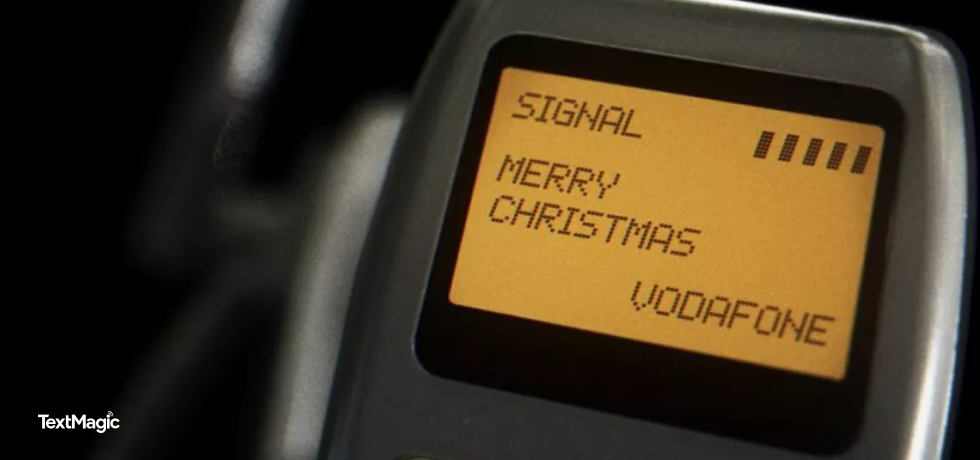
Initially, SMS was designed as a way for network operators to send important service-related information to their subscribers. However, it quickly gained popularity as people started using it to exchange personal messages. Over time, the simplicity, convenience, and cost-effectiveness of SMS led to its widespread adoption, making it one of the most widely used forms of communication in the modern digital era.
1990s: Early text messaging systems
The era of early text messaging systems began in the 1990s with the launch of the first commercial SMS services. At this time, telecommunications companies recognized SMS’s potential as a new communication channel and started offering text messaging services to their customers.
As a result, text-enabled mobile cloud phones were introduced, allowing users to send and receive short text messages. Although these early systems had limitations, such as character restrictions and basic user interfaces, they laid the foundation for the widespread adoption of SMS in the years to come, paving the way for the text messaging revolution we know today.
2000s: Expansion and popularity
In the 2000s, SMS experienced a significant expansion and surge in popularity worldwide. The adoption of text messaging grew rapidly as mobile phones became more prevalent and accessible to a broader population. This period saw an increasing number of people embracing SMS as a convenient and efficient communication method.
Mobile carriers played a crucial role in the popularity of SMS by introducing texting plans and packages. These plans allowed users to send a certain number of text messages each month for a fixed fee or included them as part of a mobile service package. As a result, texting became more affordable and appealing to consumers, further driving its widespread use.
The combination of a growing user base, improved mobile phone technology, and cost-effective texting plans led to the ubiquity of SMS as a primary communication tool during the 2000s, solidifying its position as a fundamental feature of modern mobile communication.
2010s: Evolution of texting technologies
In the 2010s, texting technologies underwent significant evolution, bringing about new ways to express and communicate.
One notable development was the introduction of the Multimedia Messaging Service (MMS). MMS allowed users to send text and multimedia content such as pictures, videos, and audio clips. This enhancement expanded the possibilities of communication, enabling users to share richer and more expressive content with one another.
Another key evolution during this decade was the integration of emojis into texts. Emojis, small pictorial icons representing emotions and objects, added a new dimension to texting by allowing users to convey emotions and ideas visually. These tiny graphics became widely popular and greatly enriched how people communicated through texts.
Furthermore, the 2010s witnessed the rise of messaging apps and platforms. These apps offered more versatile and feature-rich alternatives to traditional SMS, providing users with options for group chats, voice and video calls, stickers, and other interactive elements. Popular messaging apps like WhatsApp, Facebook Messenger, and WeChat became go-to communication platforms, particularly among younger demographics.
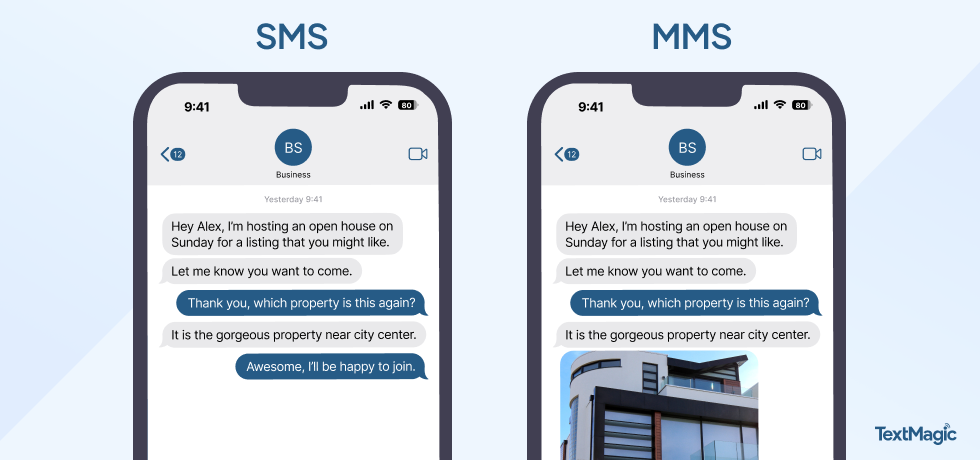
2020s: Modern texting landscape
Platforms like WhatsApp, Facebook Messenger, WeChat, and Line gained widespread popularity, surpassing traditional SMS usage. These apps provided users with enhanced features, such as multimedia messaging, group chats, and voice/video calling, transforming how people connect and communicate.
AI-powered chatbots have become increasingly common, enabling businesses to automate customer interactions, provide instant responses, and handle basic inquiries. Natural Language Processing (NLP) techniques improved the accuracy and understanding of text-based conversations, delivering more personalized and human-like interactions.
Rich Communication Services (RCS) emerged as a new standard, offering enhanced features like read receipts, typing indicators, and high-quality multimedia sharing. Additionally, secure end-to-end encryption became a prominent feature to ensure privacy and data protection.
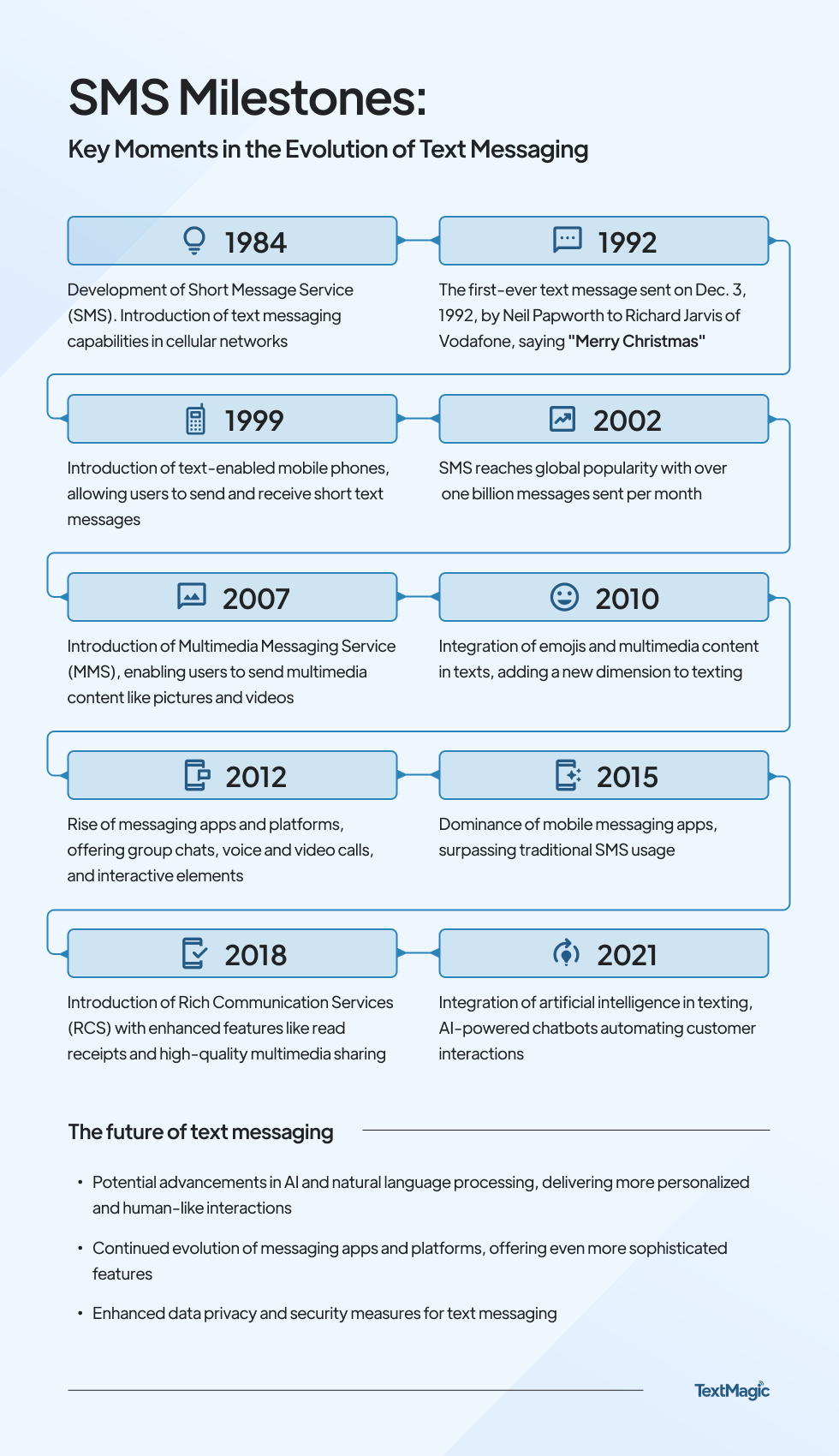
Impact of texting on communication
Texting has changed how people communicate. Many individuals now rely heavily on texting as their primary mode of communication, surpassing traditional phone calls or emails.
It also introduced new language and communication patterns. Abbreviations, acronyms, and emoticons have become prevalent in text messages to convey thoughts concisely and express emotions.
Texting enables individuals to maintain constant contact, stay connected, and share important updates. It has become a primary tool for arranging plans, staying in touch with family and friends, and growing any type of business.
Future trends in texting
The future of text messaging will be marked by increased interactivity, personalization, and integration with emerging technologies. Integrating artificial intelligence (AI) and chatbot technology with text messaging will revolutionize customer interactions.
As technology evolves, texting is poised to witness exciting trends to enhance its capabilities and impact communication further. Some of the key future trends in texting include:
- Richer multimedia content: Texting will embrace even more diverse and dynamic multimedia content, allowing users to send and receive high-quality images, videos, 3D content, augmented reality (AR) experiences, and more.
- AI-powered conversations: Artificial intelligence (AI) and natural language processing (NLP) will play a significant role in texting, enabling advanced chatbots and virtual assistants to engage in more natural and context-aware conversations with users.
- Integration of business services: Texting will increasingly become an integral part of business-customer interactions, with features like appointment scheduling, customer support, and order tracking all seamlessly incorporated into text messaging.
- Enhanced security and privacy: As the importance of data security grows, texting will adopt advanced encryption techniques to ensure the privacy and protection of personal information shared during conversations.
- 5G and faster connectivity: The widespread adoption of 5G networks will facilitate lightning-fast texting experiences, reducing latency and enabling near-instantaneous delivery of messages.
- Internet of Things (IoT) integration: Texting will be integrated with IoT devices, allowing users to control and communicate with various smart devices, home appliances, and even vehicles through text messages.
- Multi-device synchronization: Users will enjoy a seamless texting experience across multiple devices, allowing them to start conversations on one device and seamlessly continue them on another.
- Contextual communication: Texting platforms will become more context-aware, predicting user intent and providing relevant suggestions for responses, making texting more efficient and intuitive.
- Voice and video integration: Text messaging will incorporate voice and video calling functionalities, enabling users to effortlessly switch between different modes of communication within the same conversation.
- Personalization and customization: Texting platforms will offer greater personalization options, allowing users to customize their messaging experience with unique themes, fonts, and emoticons.
These trends and predictions in texting promise to shape the way we connect, collaborate, and share information, making texting an even more powerful and indispensable communication tool in the years to come.
Textmagic and SMS marketing
Text messages have a higher response rate compared to other forms of marketing communication. Customers are more likely to take action after receiving a text message, such as making a purchase or visiting a store.
Text marketing is often more affordable than traditional advertising methods like print or television ads, which makes it a suitable option for small and medium-sized businesses with limited marketing budgets.
Textmagic offers a reliable service, user-friendly interface, global coverage, versatile communication channels, integration capabilities, advanced features, and customer support make it a preferred choice for businesses seeking effective and efficient text messaging solutions.
Our platform is at the forefront of providing businesses with the tools and capabilities to leverage SMS marketing effectively. Its user-friendly interface, advanced features, and reliable infrastructure provide seamless and efficient communication experience.
Read more about the benefits of text messaging and how enterprise clients can use text messages to better engage with customers.
Conclusion
The history of text messaging has been nothing short of remarkable. From its humble beginnings in the 1980s as a simple means of communication through cellular networks, texting has evolved into a powerful and ubiquitous form of interaction in the modern digital age.
Text messaging holds immense significance in contemporary society, and its role is expected to expand even further in the future.
Try Textmagic today!
Frequently Asked Questions (FAQs)
The public’s ability to send text messages began in the mid-1990s, right after the first SMS was sent in 1992. Then, the commercialization of SMS services by mobile carriers made texting a common communication method.
The late 1990s saw a rise in texting’s popularity, driven by the widespread adoption of mobile phones and the availability of affordable texting plans. By the early 2000s, texting had become a mainstream communication method.
Texting became more popular than voice calling in the early 2000s, with younger generations leading the shift. Factors such as the rise of unlimited texting plans and the increasing use of mobile phones for messaging contributed to this trend.
Group texting, as we know it today, didn’t become a common feature until the early 2000s. Mobile carriers and phone manufacturers began offering this function to meet the growing demand for more dynamic communication options.
Nowadays, group texting is supported on business texting platforms like Textmagic, which makes it easy to send group texts to customers, staff, or subscribers, all from a single platform.
Related articles
16 Use cases of text messaging for small businesses
Text message marketing is often seen as a tool used ...
10 Best customer service books to read in 2025
Creating the best customer experience starts and end...
4 Easy Gmail SMS integrations with Textmagic and Zapier
Gmail is Google’s free email service, offering users...
What is CPaaS (Communications Platform-as-a-Service)?
Communications Platform as a Service (CPaaS) is cruc...
Cold texting: A complete guide & why you should warm text instead
This article explains the concept of cold texting an...


